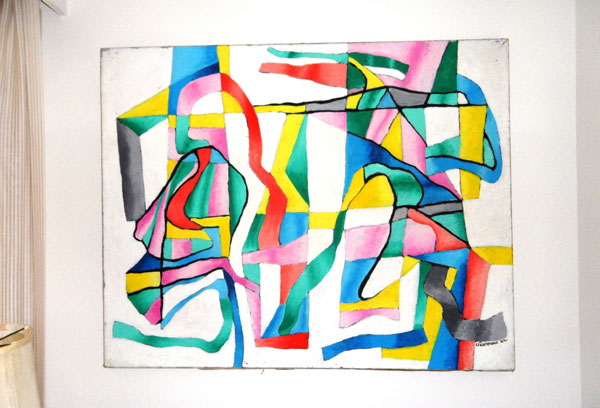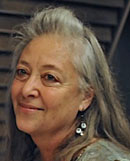 |
|
|
|
|
 |
 |
|
Kandinsky's Influence on a Young Painter:
A Personal Perspective
Rene Lichtman
|
 |
 |
|
Introduction
Lissa Tyler Renaud
Editor, "Kandinsky Anew" series
In the 2019 introduction to this "Kandinsky Anew" series, I wrote:
Over the years, Kandinsky studies have thrived under the care of a tight-knit group of intrepid scholars who publish and confer. But Kandinsky
seems to me to be everywhere… I know more than a few people who are not scholars or authors evoking Kandinsky's name, but who nevertheless have important Further
Perspectives, being among the most interesting thinkers on Kandinsky, having dedicated much rumination to the deeper meanings of his life and work.
And thus we come to the "further perspective" of this month's guest writer, the extraordinary painter Rene Lichtman. Dr. Lichtman
has a heightened sense of Kandinsky as the inspiration for, and influence on, his own painting. He was also there when Kandinsky was having his impact at the heart of
America's art world. I asked him to write about his direct contact with students of the Bauhaus who had fled Europe and surfaced in the U.S. as teachers. In response he has
written this very personal piece on the role Kandinsky has played in his long art practice and thinking.
Lichtman brings to his work, and to the telling of his story, a
particular background. He was born in Paris in 1937 to Polish refugees and, from the age of two, survived the Nazi occupation of France taken in by a Catholic couple in the
countryside. At 13, he immigrated to the U.S. with his mother. Today, he is founder of the Hidden Children Organization, President of the Holocaust Education Coalition, and
founding member and vice-president of the World Federation of Jewish Child Survivors of the Holocaust.
What follows is Rene Lichtman's unusual, first-person account—not, as he says, what the critics or even Kandinsky himself said, but
what he thought and felt—what he experienced—as a young artist in volatile, fertile times.
*
Kandinsky's Influence on a Young Painter:
A Personal Perspective
Rene Lichtman
Much has been written about Kandinsky, and much of his work has been exhibited. I spent many hours, long ago, at the Guggenheim Museum in New
York, viewing their collections, the largest collection of Kandinskys in the world. I spent days at "the Modern" seeing his work in the context of the many schools he could
relate to, the German Expressionists, the Fauves, the Northern Europeans, the Cobra group, the Bauhaus artists… Where the vanguard was exploring, Kandinsky was there.
It is one thing to read Kandinsky's theories, which greatly influenced me as a young artist, and to read what critics have said about him and
his works – that is one thing – and the other is what a young artist feels and thinks about what this fellow artist did, what he contributed, how his art influenced
others at the time, some sixty years ago, and how he continues to influence today.
The young painter at the time was me, in the early 1960s in the heart of Abstract Expressionism, or the New York School, Action Painting, as
Clement Greenberg named the school, or 8th, 9th, and 10th Streets, where the galleries were, and which was also the neighborhood where I lived and painted. I learned soon: that
was the center of the art world at the time.
I was attending the Cooper Union Art School and some of my teachers were Bauhaus alumni, had been students there. They still had their European
accents—one couldn't be sure whether German or Austrian, or something else. Little by little I learned about the Bauhaus and at the same time about Kandinsky.
I worked in "the Village," or West Village, or "little Italy" to us from the much poorer East Village. I worked during the day and went to
"Cooper" at night. The weekends I spent in the museums, looking at art, but mostly modern art. I got to know all the galleries at the Modern.
The majority of my teachers at Cooper were young and very influenced by the New York School. You could tell by the artists they suggested we
look at, for various reasons, usually because of the way we were working. So we looked at American painters, but I also looked at the painters from Europe, from different
countries and different schools.
At the same time as having young, contemporary painters teaching at Cooper, there were also older teachers. I took classes in Design and even
Calligraphy from artists who it turned out were European, with accents. I learned at some point they had been to the Bauhaus. I had no idea what that was for some time.
The Bauhaus teachers, many of them, came to the USA, with their theories, influenced by psychology, such as automatism and others. So we have
the New York School influenced by automatism, the unconscious, the physical gesture. I was very aware of that movement from Paris, my birthplace, to now New York City, where I
lived, spent years in those streets of the Lower East Side. I was too young and serious to attend the Cedar Bar and other hangouts. I was the generation between the Bohemians
and the Hippies.
Connecting the dots…
But between the various influences that came up in the act of painting, and the visits to galleries and museums, slowly many lessons for a young
painter are learned. For example for some time I was influenced by Les Fauves, those "savage" French painters with those colors, right out of the tubes, and at the museums I
would see the German Expressionists and Blaue Reiter (Blue Rider) groups, and always Kandinsky, just one or two paintings in each gallery.
At some point I saw the Guggenheim full of Kandinskys. Periodically "the Guggy" would bring them all out at one time, and at those exhibits I
was able to see Kandinsky's different "styles" or "periods," one more expressionist in his use of raw color and surface, the other style more geometric with muted colors.
At the same time I was reading his Point and Line to Plane. For me the book was such a beautiful lesson in why we make abstract art, the
challenge of facing an empty canvas… and putting down a dot or point in that space. The line made me think of my love of Archile Gorky, with his sensuous, organic
elements, his close ups of the organic life of the soil on his farm, his use of the line. Discussing planes made me consider Cezanne and the Cubists. I had never considered the
relationship of art elements, color, to music. Kandinsky wrote about it and opened not only my eyes but my ears as well. I was never mystical to the degree he was, but I noted
that his ideas were beginning to influence my painting, my palette.

Leger's Dream, Rene Lichtman
What I found most interesting was Kandinsky's attachment to both expressionist ideas and to ideas for the new geometric influences.
What I could see during a large collection of his works was that combination of expressionism and of the geometric tendency. I was
going through such phases in my own painting. The New York School, or Action painting, was all energy, machismo, intuition, automatism,
large scale, the large gesture. Jackson Pollock. Kandinsky did not have the scale, Europe is relatively small, but many of his paintings have the
gesture, controlled, the busy linear elements, the surface is busy all over. And in many works, there is in contrast to the busy area or
elements, there is a geometric area, stable, grounded. He combined the two major forms of expression, expressionism, passion, the lyrical, with
the stability of the geometric, reason, control.
I recall reading or hearing the story of how he "invented" abstract art. I'm not sure what country he was in but he had been on a walk, on a
snowy day, and was returning to his studio. Because of the brightness of the snow, when he entered his studio his vision took a while to
acclimate. In a corner on the floor he saw something that took him aback. In fact, it was his own painting, upside down. The shapes and
colors struck him as beautiful and not attached to objects. One recalls his reaction when he first saw a Monet Haystack, where the colors and
brushstrokes were independent of the object.
Why have I always been so intrigued with the Bauhaus, with those professors, teachers, I had at Cooper Union? Part of my interest I am
sure stems from my own childhood with fascism, and the fact that so many of these amazing artists, not only painters but from various art
fields, were forced to flee fascism. Hitler called them "degenerate" and I loved all of them. I considered them very brave, as artists, always
jumping into the unknown, always experimenting, seldom receiving "recognition."
Over the years I have given presentations on what I feel are, and have been, the two major trends in modern art. These are Expressionism
and Geometric Abstraction. I have always been influenced by both trends, at different phases of my painting. Geometric Abstraction
began in Russia in the early 1900s with the strict geometry of Malevich and the others, and that school has lasted until today. The other school,
the Expressionist tradition, also began long ago, in Central and Western Europe, and continues until today. Bridging these two traditions, year after year, has been Kandinsky.

Rene Lichtman, PhD
Lichtman (b. 1937) attended various art programs, workshops and schools. After
La Guardia High School of Music and Art in Manhattan, he continued to paint, show his work, and design sets while in the army. He graduated from the famed
Cooper Union School of Art in Manhattan's East Village. In Provincetown, Mass. on a scholarship, he worked as an assistant to celebrated artists Robert
Motherwell and his wife, Helen Frankenthaler. Lichtman was a Fulbright Scholar in painting in Brussels. Along the way, he toured with the Living Theatre,
and has been a photographer and filmmaker. Now living in Michigan, he is an engaged political activist, a sought-after speaker on the arts, and a much
-recognized painter—exhibiting in both group and solo shows—whose work is deeply influenced by Kandinsky.
|
|
|
|
 |
|
|
 |
|

Curator, writer and editor, Kandinsky Anew Series
Lissa Tyler Renaud BA Acting, MFA Directing, PhD Dramatic Art with Art History (on Kandinsky's theatre), summa cum laude, UC Berkeley (1987). Founder, Oakland-based
Actors' Training Project for training based on Kandinsky's teachings (1985- ). Lifelong actress, director. Book publications: The Politics of American Actor Training (Routledge);
an invited chapter in the Routledge Companion to Stanislavsky. Has taught, lectured and
published widely on Kandinsky, acting, dramatic theory and the early European avant
-garde, throughout the U.S., and since 2004, at major theatre institutions of Asia, and in England, Mexico, Russia and Sweden. She is a senior writer for Scene4.
For her other commentary and articles, check the Archives.
 |
 |
|
* * *
This article will be included in an easily accessible
Index for the entire series. If you are not currently
a subscriber to Scene4 but would like to be notified
whenever a new article is added to
the series, please send us your email address..
|
|
|
|
|
|
|
|
|
|
|
 |
 |